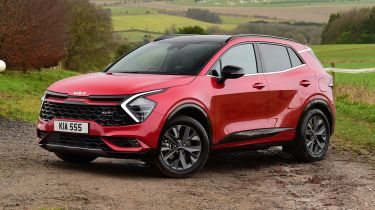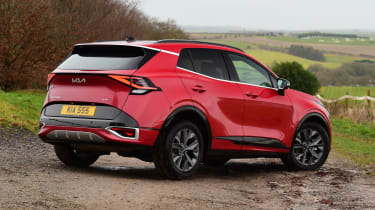Kia Sportage SUV - MPG, running costs & CO2
Something for nearly everyone in the Sportage’s engine range
Every Kia Sportage features a 1.6-litre engine but there’s a comprehensive range of hybrid options. Now even entry-level models get a mild-hybrid version of this engine but move up the range and you can choose a full-hybrid or plug-in hybrid. The mild-hybrid has a starter-generator that collects a small amount of electricity when you brake and acts like an extended start-stop system. Don’t expect to see major fuel savings, though.
The biggest difference between the hybrid and plug-in hybrid is the size of the battery (and the price), with the hybrid getting a small 1.49kWh unit compared to a 13.8kWh one for the plug-in hybrid. The latter needs to be recharged from a plug socket or charging point but the result is an impressive 43-mile electric-only range; the normal hybrid won’t manage more than a mile or so at a time, although it does automatically switch to electric power as frequently as possible.
The plug-in hybrid’s 7.2kW charging capability means a full charge from a home wallbox will take just an hour and three quarters.
Given that the Sportage is more technologically advanced than before, and has a broader range of engines, it’s not surprising that prices are higher than for its predecessor. A top-spec hybrid model costs over £40,000 (the plug-in hybrid tops out past £45,000), and our test car required a near-£10,000 deposit to bring monthly payments down to £315. Kia will have changed their deals since, though, so it’s worth looking out for retailers offering incentives.
Kia Sportage MPG & CO2
Unsurprisingly, the versions with a higher level of electrification offer the lowest running costs. The plug-in hybrid Sportage offers up to 43 miles of electric driving on a full charge, which should be enough for the average daily commute. If you can predominantly drive using the electric motor and recharge frequently your fuel costs will be minimal. Officially, the plug-in hybrid is capable of up to 252mpg, which may be possible if you rarely use the petrol engine; we saw 87mpg on our mixed-route test.
While the discontinued diesels offered fuel economy up to 55.4mpg, they’re not really missed, as that figure wasn’t too much more than the 49.6mpg Kia quotes for the hybrid. The cheaper mild-hybrid manages up to 44.1mpg; similar figures to a Nissan Qashqai or SEAT Ateca.
The hybrid has CO2 figures starting at 129g/km, putting it in an upper band for Benefit-in-Kind (BiK) tax for company-car drivers. The diesel emits a similar amount of CO2 when equipped with front-wheel drive and an automatic gearbox, making it an affordable choice for business users too. But business users should at least consider the plug-in hybrid, as its relatively high P11D value is offset by its 25g/km CO2 emissions, putting it in one of the very lowest BiK bands.
All hybrid versions get a slightly discounted rate of VED (road tax), but it's possible to spend over £40,000 on a Sportage. Tip over this threshold and you'll pay an extra tax surcharge, taking your annual bill to over £500 until the car is six years old. This is especially relevant for the plug-in hybrid, because the extra tax you’ll pay could cancel out the fuel savings.
Insurance groups
The hybrid and plug-in hybrid Sportage models sit in groups 24-26 out of 50, depending on the trim level. The cheapest to insure is the entry-level ‘2’ trim with the underpowered 114bhp diesel engine, as it sits in group 15. That’s roughly what you’d expect from a family SUV, although it is higher than the Nissan Qashqai, which sits in group 12 in mid-spec mild-hybrid guise. Other diesel versions sit in groups 16-18, and the petrol occupies 17-20.
Warranty
Kia’s seven-year/100,000-mile warranty is no longer quite class-leading (the Toyota RAV4 and C-HR can be covered for up to 10 years, although it requires you to always have the car serviced by a main dealer) but it’s still far more generous than the three years of cover you get with a Volkswagen Tiguan or BMW X1. It can be transferred to the next owner too.
Servicing
Taking out a Kia Care service plan sees your servicing covered for two, three or five years, and can be paid monthly or upfront. It costs around £500 for three services for the basic petrol engine, while the full hybrid will set you back nearly £600 over the same period. Kia also offers a ‘Drive Now, Pay Later’ scheme that allows you to pay for maintenance work over three instalments interest-free.
Whichever engine you pick, it’ll need to be serviced annually or every 10,000 miles. High-mileage drivers may be better off in a car with longer service intervals; the BMW X1 can go up to two years between services if it’s mainly used on motorway trips.










